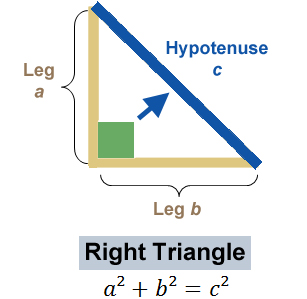
The Pythagorean Theorem is used with right triangles where the lengths of the legs of the triangle are used to find the length of the hypotenuse or the lengths of the hypotenuse and one leg are used to find the measure of the remaining leg. The legs of the right triangle are labeled a and b, and the hypotenuse is labeled c.
You may recall from 8th grade that the Pythagorean Theorem is:

Important: For the theorem to work every time, “a” must represent one leg of the right triangle, “b” must represent the other leg of the right triangle, and “c” is always the hypotenuse.

![]() Activity: Click on the link below to open the Sketch applet in a new tab or window. Follow the steps of the investigation beneath the sketch. When you have completed step 6, return to this lesson and respond to the journal entry.
Activity: Click on the link below to open the Sketch applet in a new tab or window. Follow the steps of the investigation beneath the sketch. When you have completed step 6, return to this lesson and respond to the journal entry.
Exploring the Pythagorean Theorem
Journal Entry: How do the areas of the two smaller squares, whose side lengths are equal to the lengths of the legs of the right triangle, compare to the area of the largest square, whose side length is equal to the length of the hypotenuse? Use a picture to illustrate your response.
Interactive popup. Assistance may be required.
The sum of the area of two squares built on the legs of a right triangle is equal to the area of a square built on the hypotenuse of a right triangle.